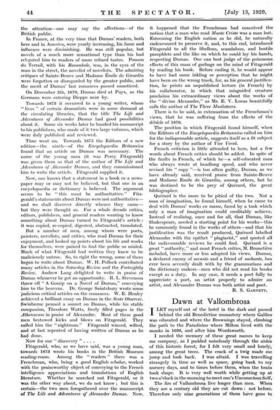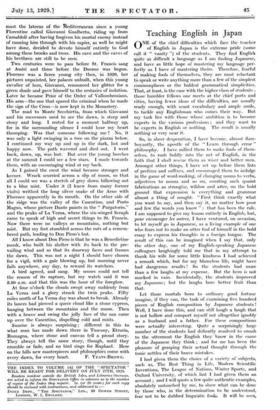Dawn at Vallombrosa
ILET myself out of the hotel in the dark and passed behind the old Benedictine monastery where Galileo was educated and where the Brownings stayed, climbing the path to the Paradisino where Milton lived with the monks in 1638, and after him Wordsworth. • - I needed the memory of these great names to keep me company, as I padded noiselessly through the aisles of this historic forest, for I felt very small and lonely, among the great trees. The crack of a twig made me jump and look back. I was afraid. I was travelling strangely in time as well as space, going back to my nursery days, and to times before them, when the brain took shape. It is very well worth while getting up at two o'clock in the morning to meet one's Unconscious Self; The firs of VallcimbroSa live longer than men. When they are a century old they are cut down : not before: . Therefore only nine generations of them hive gone to mast the lateens of the Mediterranean since a young Florentine called Giovanni Gualberto, riding up from Camaldoli after having forgiven his mortal enemy instead of running him through with his rapier, as well he might have done, decided to devote himself entirely to God among these brooks and trees. His cave and the eaves of his brethren are still to be seen.- Two centuries were to pass before St. Francis sang at Assisi and three before the Duomo begun. Florence was a fierce young city then, m 4020, her pictures unpainted, her palaces unbuilt, when this young cavalier of hers, Giovanni, renounced her glitter for a green shade and gave himself to the ecstasies of isolation. Later he became Prior of the Order of Vallonabrosians. His arm—the one that spared the criminal when he made the sign of the Cross—is now kept in the Monastery. The road to -Monte- Secchietta, from which Giovanni and his successors used to see the dawn, is steep and stony and long. I rested for a moment halfway up, for in the surrounding silence I could hear my heart thumping. Was that someone following me ? No, it was only a light swinging *in- a tree on the pinzza. below. I continued my way up and up in the dark, hot and • happy now. The path wavered and died out. I went back, down, up, was lost. But over the young beeches at the summit I could see a few stars. I made towards them, with an encouraging wind at my back. As I gained the crest the wind became stronger and keener. Wrack scurried across a slip of moon, so that all I could see was a stretch of grey down 'billowing out to a blue mist. Under it (I knew from many former visits) writhed the long silver snake of the Arno with Florence apparently in its mouth. On the other side of the ridge was the valley of the Casentino, and Prato Magno, whose picture Dante paints in the " Purgatorio," and the peaks of La Verna, where the six-winged Seraph came to speak of high and secret things to St. Francis. Now there were no valleys or mountains, nothing but mist. But my feet stumbled across the ruts of a remem- bered path, leading to Don Piero's hut. All I know about Don Piero is that he was a Benedictine monk, who built his shelter with its back to the pre- vailing wind and so that its doorway faces and frames the dawn. This was not a night I should have chosen for a vigil, with a gale blowing up, but morning never fails anywhere, any day, to reward its watchers. A bird agreed, and sang. My senses could not tell the reason of its rapture, but my watch said it was 3.30 a.m. and that this was the hour of the foreglow. At four o'clock the clouds swept away suddenly from La Verna and a glory struck the twin peaks. Fifty miles north of La Verna day was about to break. *Already its lances had pierced a queer cloud like a stone cypress, hanging between the mountains and the moon. Then with a heave and swing the jolly face of the sun came up over the Casentino, dispelling cold and mists. Sunrise is always surprising ; different in this to what man has made down there in Tuscany, Etruria, Romagna, where stone and canvas tell a proud story. They always tell the same story, though, until they crumble or fade, and no bird sings for Raphael. ' Here on the hills new masterpieces and philosophies come with

































 Previous page
Previous page